adding weight to 2wd for winter traction
#1
adding weight to 2wd for winter traction
i think a lot of us that have 2wd trucks and live in areas that accumulate significant amounts of snow throw weight in the bed to get better traction.
this winter i have got (4) 50 lb. sand bags in my bed, positioned over the rear axle (where everyone often recommends).
knowing something about forces and statics, i wonder if the weight would be more efficiently used if it was placed at the back against the tailgate though. here is the reason why (note this is not my truck, and i just assumed some distances for the calcs):
#1 - weight above rear axle:

by summing the moment at the front axle, the reaction at the wheels (R1) = (10' x 200 lbs.) /( 10') = 200 lbs.
#2 - weight at the rear, near tailgate:

by summing the moment at the front axle, the reaction at the wheels this time (R2) = (13' x 200 lbs.) /( 10') = 260 lbs. so by moving the weight farther back you are increasing the rear traction advantage you have. it would also take 60 lbs. off the front end though (equilibrium of forces, reaction at back + reaction at front = weight applied of 200 lbs), so you could lose a little front end traction (probably insignificant because of the weight of the engine, you have more then enough weight over the front wheels).
however if the back end does slip out, it will have more rotational momentum and speed due to the weight being all the way at the back.
this winter i have got (4) 50 lb. sand bags in my bed, positioned over the rear axle (where everyone often recommends).
knowing something about forces and statics, i wonder if the weight would be more efficiently used if it was placed at the back against the tailgate though. here is the reason why (note this is not my truck, and i just assumed some distances for the calcs):
#1 - weight above rear axle:

by summing the moment at the front axle, the reaction at the wheels (R1) = (10' x 200 lbs.) /( 10') = 200 lbs.
#2 - weight at the rear, near tailgate:

by summing the moment at the front axle, the reaction at the wheels this time (R2) = (13' x 200 lbs.) /( 10') = 260 lbs. so by moving the weight farther back you are increasing the rear traction advantage you have. it would also take 60 lbs. off the front end though (equilibrium of forces, reaction at back + reaction at front = weight applied of 200 lbs), so you could lose a little front end traction (probably insignificant because of the weight of the engine, you have more then enough weight over the front wheels).
however if the back end does slip out, it will have more rotational momentum and speed due to the weight being all the way at the back.
Last edited by the.hatter; 01-09-2009 at 12:38 PM.
#3
You going for engineering? I'm impressed, never thought I'd see statics on Ranger-Forums! Lol
Although, the drawings weren't impressive
Moving the bags to the back does does transfer more weight from the front wheels to the back wheels, by creating an imaginary moment arm. And you were also right about rotational momentum. However, I'd get a few more sand bags anyways In my old 2wd I think I had 6 60# sand bags.
In my old 2wd I think I had 6 60# sand bags.
EDIT, and I'm sure Sully will be thrilled to see his truck as the "background" for these drawings haha. I own those wheels now!!!!!!!
Although, the drawings weren't impressive

Moving the bags to the back does does transfer more weight from the front wheels to the back wheels, by creating an imaginary moment arm. And you were also right about rotational momentum. However, I'd get a few more sand bags anyways
 In my old 2wd I think I had 6 60# sand bags.
In my old 2wd I think I had 6 60# sand bags.EDIT, and I'm sure Sully will be thrilled to see his truck as the "background" for these drawings haha. I own those wheels now!!!!!!!
Last edited by freddie; 01-09-2009 at 01:52 PM.
#4
EDIT - You already calculated the reduced front weight.
#8
I was really interested in this till I got to "by summing the moment at the front axle, the reaction at the wheels."
You totally lost me with all that math stuff.
I usally throw 3 concrete blocks in the back over the axle. They are 16" x 16" x 4" thick. I weighted them at work each one weighs different anywhere from 90 -100 pounds
I have never had problems getting traction. I recently switched my axles out and I'm waiting some snow this year to see how it works with the new axle
You totally lost me with all that math stuff.
I usally throw 3 concrete blocks in the back over the axle. They are 16" x 16" x 4" thick. I weighted them at work each one weighs different anywhere from 90 -100 pounds
I have never had problems getting traction. I recently switched my axles out and I'm waiting some snow this year to see how it works with the new axle
#11
#12
#13
i think a lot of us that have 2wd trucks and live in areas that accumulate significant amounts of snow throw weight in the bed to get better traction.
this winter i have got (4) 50 lb. sand bags in my bed, positioned over the rear axle (where everyone often recommends).
knowing something about forces and statics, i wonder if the weight would be more efficiently used if it was placed at the back against the tailgate though. here is the reason why (note this is not my truck, and i just assumed some distances for the calcs):
#1 - weight above rear axle:

by summing the moment at the front axle, the reaction at the wheels (R1) = (10' x 200 lbs.) /( 10') = 200 lbs.
#2 - weight at the rear, near tailgate:

by summing the moment at the front axle, the reaction at the wheels this time (R2) = (13' x 200 lbs.) /( 10') = 260 lbs. so by moving the weight farther back you are increasing the rear traction advantage you have. it would also take 60 lbs. off the front end though (equilibrium of forces, reaction at back + reaction at front = weight applied of 200 lbs), so you could lose a little front end traction (probably insignificant because of the weight of the engine, you have more then enough weight over the front wheels).
however if the back end does slip out, it will have more rotational momentum and speed due to the weight being all the way at the back.
this winter i have got (4) 50 lb. sand bags in my bed, positioned over the rear axle (where everyone often recommends).
knowing something about forces and statics, i wonder if the weight would be more efficiently used if it was placed at the back against the tailgate though. here is the reason why (note this is not my truck, and i just assumed some distances for the calcs):
#1 - weight above rear axle:

by summing the moment at the front axle, the reaction at the wheels (R1) = (10' x 200 lbs.) /( 10') = 200 lbs.
#2 - weight at the rear, near tailgate:

by summing the moment at the front axle, the reaction at the wheels this time (R2) = (13' x 200 lbs.) /( 10') = 260 lbs. so by moving the weight farther back you are increasing the rear traction advantage you have. it would also take 60 lbs. off the front end though (equilibrium of forces, reaction at back + reaction at front = weight applied of 200 lbs), so you could lose a little front end traction (probably insignificant because of the weight of the engine, you have more then enough weight over the front wheels).
however if the back end does slip out, it will have more rotational momentum and speed due to the weight being all the way at the back.

#14
heres my truck:

wheels are getting painted black this spring (already did the centercaps)
i was going to get a 4x4, but my parents had this truck (a 2wd) as a 3rd vehicle that didnt get driven often, and were looking to get rid of it. i knew they took care of it, plus they let me buy it from them interest free :)
next fall i am going to get a decent set of A/T tires, think that will help a good bit.
#15
Here are the pics I posted the other day....
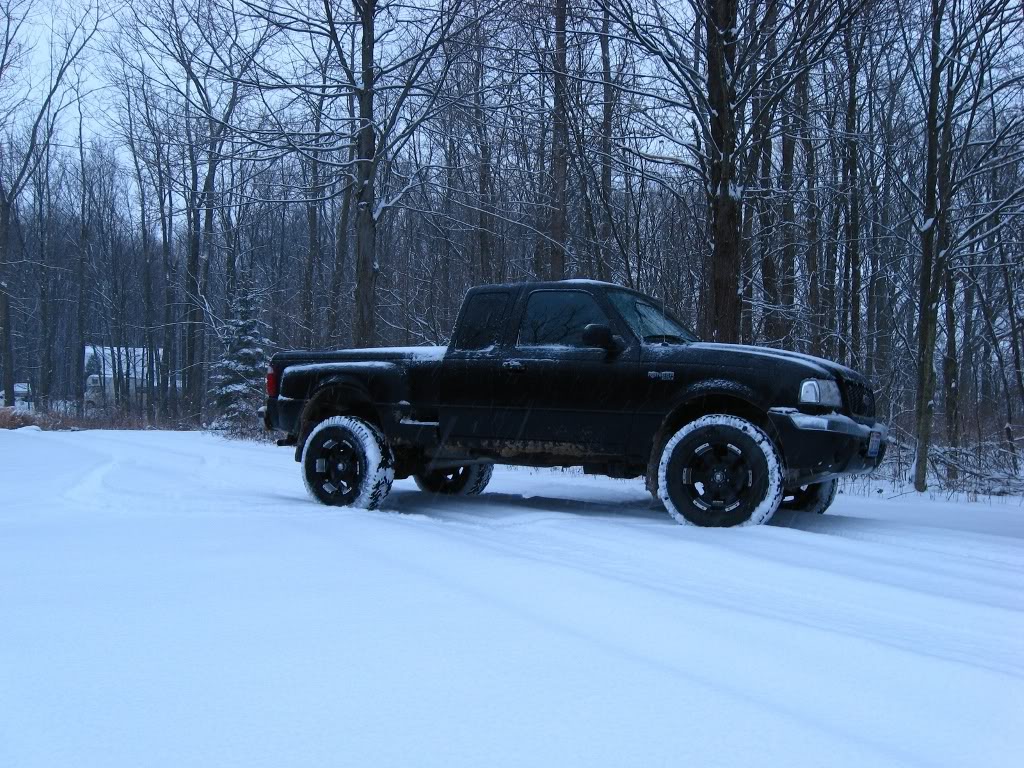
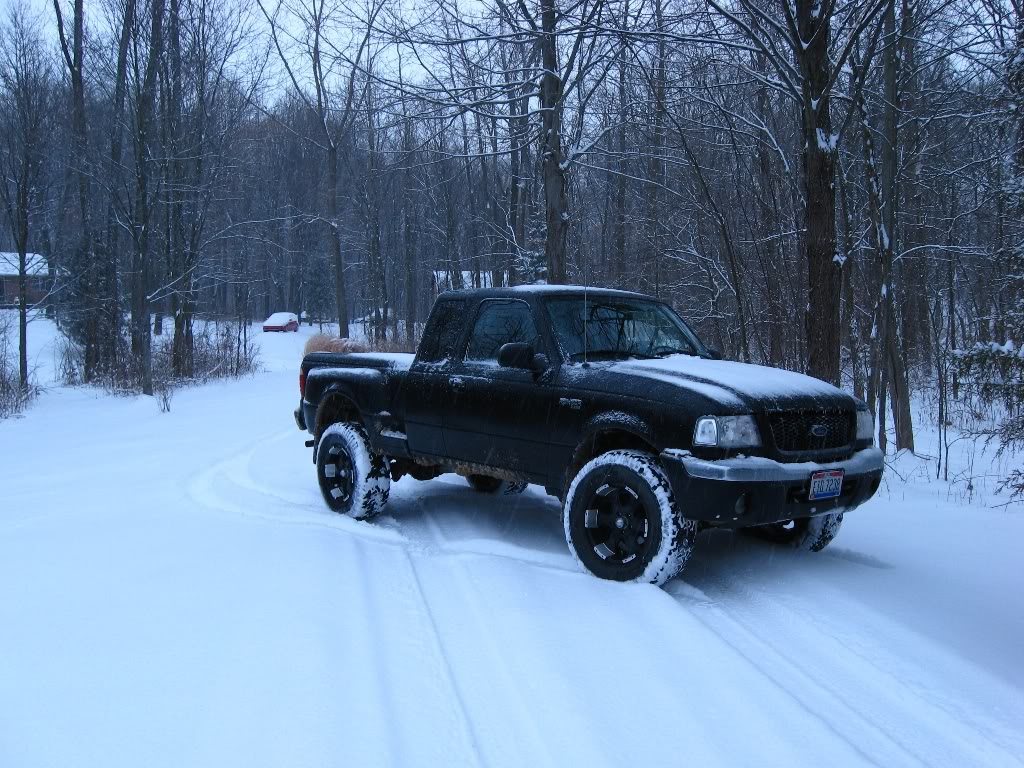
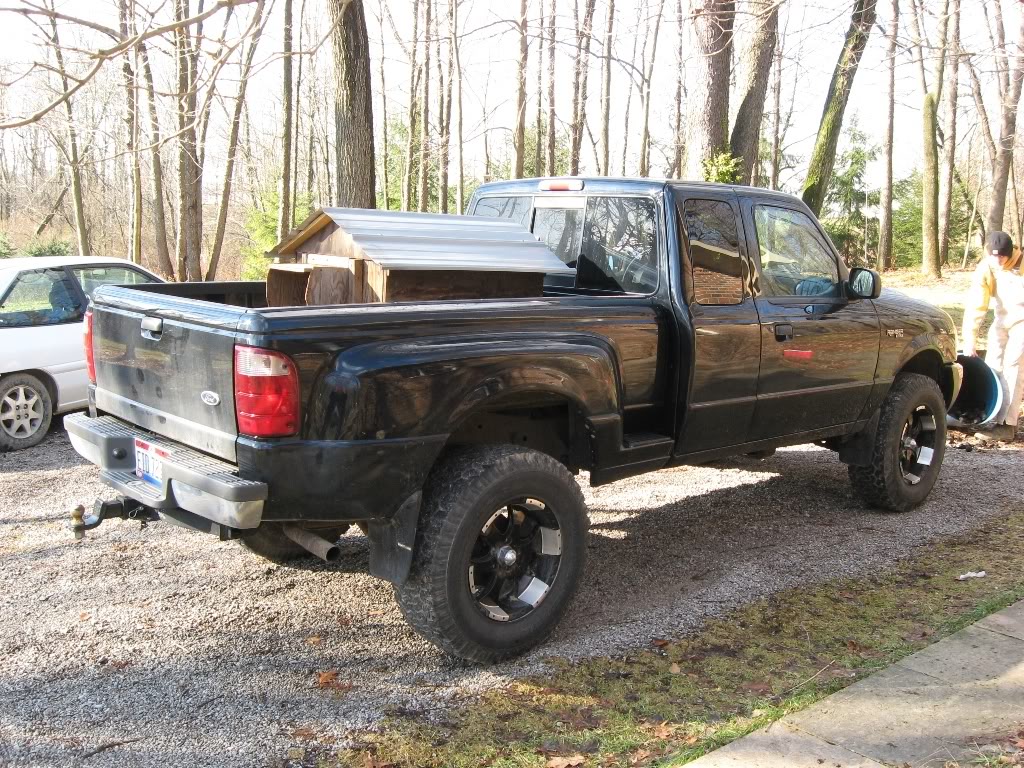
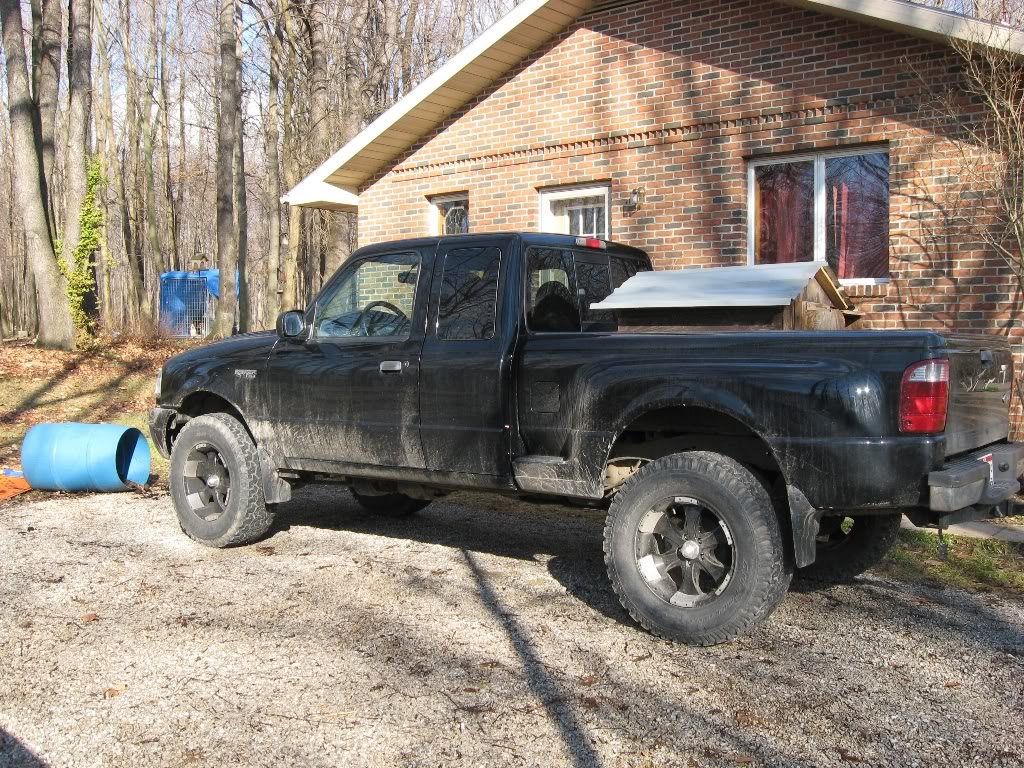
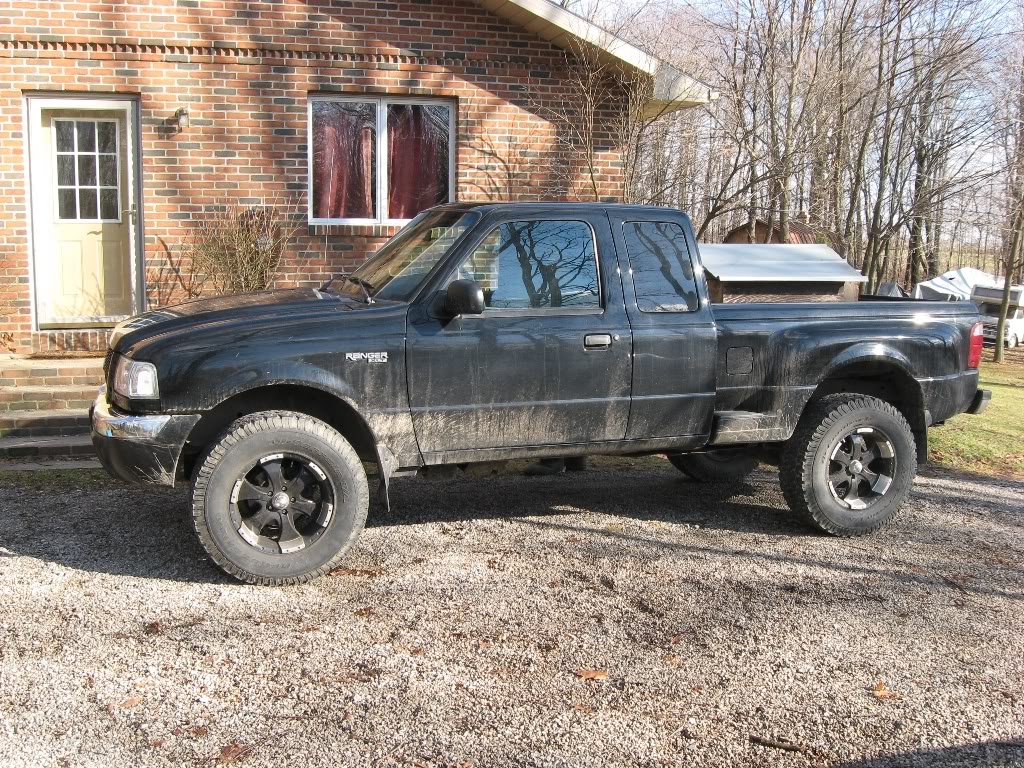
You should definitely paint the wheels black, and buy some 31x10.5x15 BFG A/T's! That's what I've got on my 98 2wd:
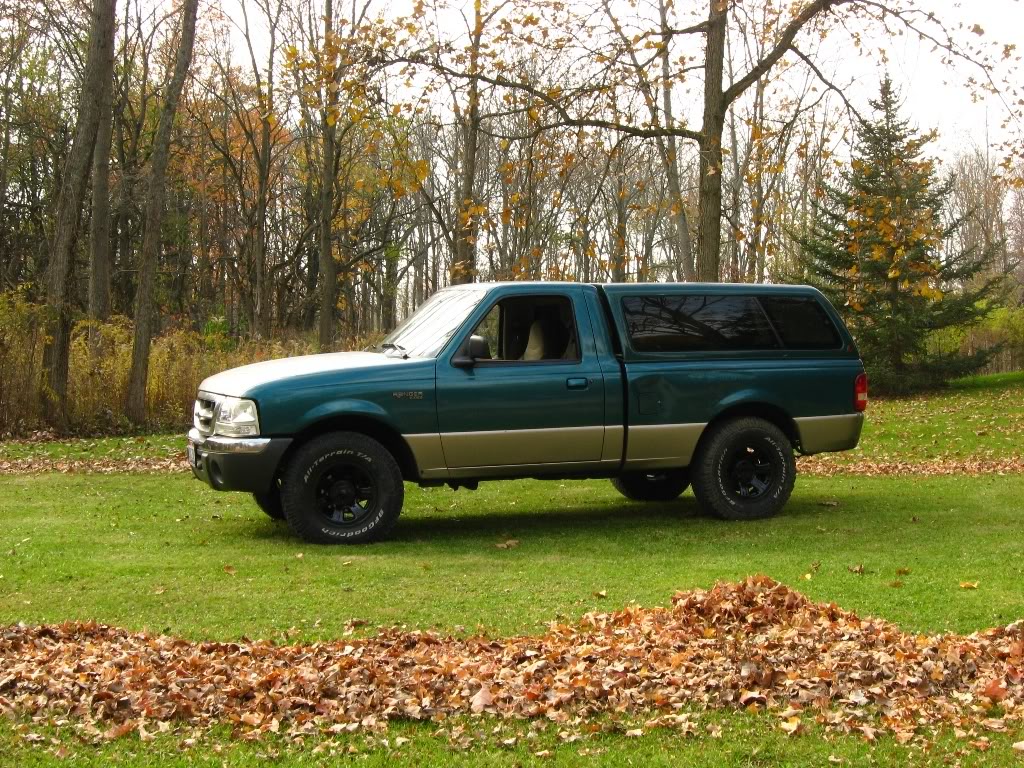
I think it looks good..
I think you should paint those wheels black, and get the 31x10.5x15 BFG A/t's, they'lll fit. Plus, they're AWESOME tires, in snow, rain, etc. Go white letter out too. They'd look awesome on your truck, I totally promise, esp with the black wheels!





You should definitely paint the wheels black, and buy some 31x10.5x15 BFG A/T's! That's what I've got on my 98 2wd:

I think it looks good..
I think you should paint those wheels black, and get the 31x10.5x15 BFG A/t's, they'lll fit. Plus, they're AWESOME tires, in snow, rain, etc. Go white letter out too. They'd look awesome on your truck, I totally promise, esp with the black wheels!
#18
I have always put the weight on the back. I ain't a math guy. :)) I have never run into a dangerous light front end from it (shocks do some countering to this). The one thing your calculations don't take into account is when she breaks loose. The extra weight is at the outside of the arch. When your rear end breaks loose you will understand what I am talking about. My fix for this is practice in an empty snowy parking lot and training myself to use my brakes, throttle and steering to counter the effect. There have been several times over the years when I used my brakes to pull the front end away from the guardrail and then used gas and steering to bring the rear end over then I just kept going down the road.
Nice job on your calcs. :)
Nice job on your calcs. :)
#20
#21
Wow, and to think I'd NEVER see any of that again!!! LOL
Now those are the type of problems we should of had in school, but noooooooooooo, we had to worry about cantalever, rotational, and friction forces on plain objects. LOL
I'm a Civil Engineer, graduated in 03. One thing I gotta hand to the Mech guys is all that math you gotta do. I couldn't stand all those math courses.
Pretty surprised you even thought of this though........but as stated before, the more weight behind the rear axle, the less weight being applied on the front wheels, where you want weight so you can steer. As much as it may sound good on paper, weight should be placed directly over the rear axles (because that's mainly where we need it, to keep that *** end plated for traction.)
Now those are the type of problems we should of had in school, but noooooooooooo, we had to worry about cantalever, rotational, and friction forces on plain objects. LOL
I'm a Civil Engineer, graduated in 03. One thing I gotta hand to the Mech guys is all that math you gotta do. I couldn't stand all those math courses.
Pretty surprised you even thought of this though........but as stated before, the more weight behind the rear axle, the less weight being applied on the front wheels, where you want weight so you can steer. As much as it may sound good on paper, weight should be placed directly over the rear axles (because that's mainly where we need it, to keep that *** end plated for traction.)
#22
Wow, and to think I'd NEVER see any of that again!!! LOL
Now those are the type of problems we should of had in school, but noooooooooooo, we had to worry about cantalever, rotational, and friction forces on plain objects. LOL
I'm a Civil Engineer, graduated in 03. One thing I gotta hand to the Mech guys is all that math you gotta do. I couldn't stand all those math courses.
Pretty surprised you even thought of this though........but as stated before, the more weight behind the rear axle, the less weight being applied on the front wheels, where you want weight so you can steer. As much as it may sound good on paper, weight should be placed directly over the rear axles (because that's mainly where we need it, to keep that *** end plated for traction.)
Now those are the type of problems we should of had in school, but noooooooooooo, we had to worry about cantalever, rotational, and friction forces on plain objects. LOL
I'm a Civil Engineer, graduated in 03. One thing I gotta hand to the Mech guys is all that math you gotta do. I couldn't stand all those math courses.
Pretty surprised you even thought of this though........but as stated before, the more weight behind the rear axle, the less weight being applied on the front wheels, where you want weight so you can steer. As much as it may sound good on paper, weight should be placed directly over the rear axles (because that's mainly where we need it, to keep that *** end plated for traction.)
#23
#25
Whatever you place in the bed for traction, please make sure that it is not prone to load shift - that can be extremely dangerous - nothing like a couple of hundred pounds of stuff slamming around in your bed under acceleration, braking or turning, or just bouncing around.
Can't argue with the logic or numbers in your calculations; further back, the weight may well give you better traction, but will have a greater effect on handling, as you noted - practice driving in an empty snow covered parking lot if that's how you want to place the extra weight.
Weight over the axles gives the extra traction with the weight directly over the contact points with the road (the tires), and probably offers less disruptive changes in handling characteristics, though, now that I think about it, close to the centre of the vehicle may be more "neutral" in a handling sense; and, now that I think about it, "directly over the axle" may also be a legacy of how/where we place/balance loads on single axle trailers; and, with a nod to traditionalists: "That's the way it's always been done - or so my pappy tells me!"
Can't argue with the logic or numbers in your calculations; further back, the weight may well give you better traction, but will have a greater effect on handling, as you noted - practice driving in an empty snow covered parking lot if that's how you want to place the extra weight.
Weight over the axles gives the extra traction with the weight directly over the contact points with the road (the tires), and probably offers less disruptive changes in handling characteristics, though, now that I think about it, close to the centre of the vehicle may be more "neutral" in a handling sense; and, now that I think about it, "directly over the axle" may also be a legacy of how/where we place/balance loads on single axle trailers; and, with a nod to traditionalists: "That's the way it's always been done - or so my pappy tells me!"
Last edited by north44; 01-13-2009 at 10:17 PM.











